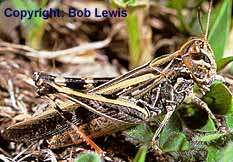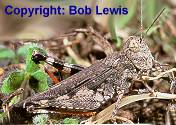Adult description 5 of 15


Size: Females 20 to 35 mm, males 10 to 25 mm
Adult Description: There are 9 named species in this genus, most sharing their range with the plague locust and 6 sharing their range with Austroicetes cruciata. Colour can vary from green to brown but only A. cruciata has the strong yellow phase while in plague. In profile the head is either straight or saddle shaped. The rear femur of most species has distinctive dark triangles, usually being prominent when seen from above. The hind wings of most species are clear and a few have a darker forward margin like in A. cruciata. Hind tibia from light straw to orange and rarely red. No throat peg.
Confusion with Australian plague locust and A. cruciata: When not in swarms, some are very similar in shape, colour and behaviour, though most are smaller than the Australian plague locust (compare photos).
Unique features: As a group, only the often saddle shaped thorax without a dark smudge on the rear wing tip or fully red tibia. Also most do not swarm.
Further information on this species: Description of nymph
